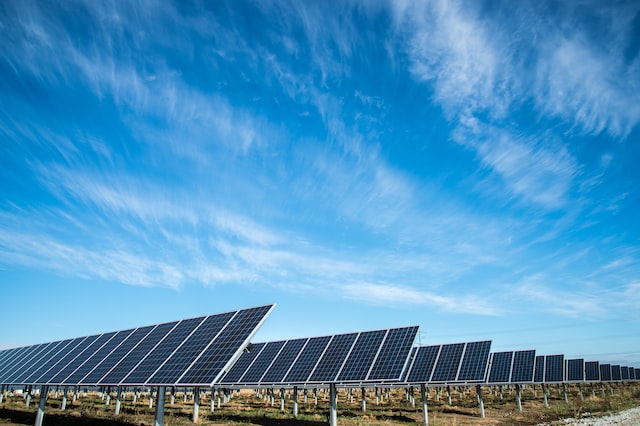
Community solar programs help residents save money by subscribing to a local solar farm that produces clean energy. That power is then sent to the electric grid and helps reduce reliance on fossil fuels.
Many communities have seen tremendous growth in their community solar programs, especially in the U.S. These initiatives are vital to the state’s Reforming the Energy Vision (REV) plan.
What is a Community Solar Program?
Community solar programs are a popular way to help people who want to save on their energy costs but can’t or don’t want to install solar panels at home. These programs allow consumers to get a share of a local solar farm and receive credits on their electricity bills based on the amount of solar the project generates.
Many community solar programs by state are built around large projects called community solar gardens, which typically have thousands of solar panels installed on them. The solar garden is then populated with subscribers, who receive the output of the solar gardens, which is sold to their electric utility for their use.
These shared renewable energy resources provide a great way to meet the increasing demand for clean, local energy and support solar in communities nationwide. Customers can use them, including businesses, universities, hospitals, places of worship, apartments, and condos.
In many states, state renewable energy incentives subsidize the community solar cost. These incentives are designed to encourage homeowners, renters, and businesses to take advantage of the benefits of solar energy by reducing their electricity bills and helping to drive the transition to cleaner, renewable power in their communities.
Most programs offer a subscription plan, where you subscribe to a specific amount of solar panels, usually at a discount compared to your average electric rate. Some also provide purchase plans, which let you own a portion of a solar farm and receive annual credit billing for your kilowatt-hours of clean electricity.
Eligibility
Community solar programs are a great way to help clean up the power grid without installing a solar array on your home or business. Instead, you can subscribe to a local solar farm and receive a credit on your electricity bill for the energy it produces.
Community Solar is a type of renewable energy rapidly expanding across the country. This is a good thing because it means more people can benefit from the clean power of solar.
There are a few different models that a solar community project can use. Still, they all follow the same basic idea: people buy or subscribe to panels in a solar farm and get a discount on their electricity bills for the electricity they use. This model can be owned by a utility, a nonprofit, or a special-purpose company created to build and own solar community projects.
Generally, people who own or subscribe to a community solar farm can also get tax credits and other incentives that make the system more affordable. However, it is essential to understand what state laws and other requirements your solar community project must follow to be eligible for these benefits.
Some states have been working hard to create more inclusive community solar programs by eliminating barriers to participation. This includes removing restrictions that limit access to the program for low-income customers or those living in multifamily housing.
Fees
Community solar programs are a great way to save money while supporting renewable energy goals. They also help clean up our environment and contribute to a more sustainable future for our power grid.
In most states, you subscribe to a portion of a local solar farm and get credits that lower your utility bill. These credits are enabled by state renewable energy incentives and can come as a discount on your electric bill–like a reward for your support of the environment! These credits are based on the solar energy that the farm generates.
Community solar costs mainly depend on your location and the subscription size. You may save as much as 15% on your electricity costs.
For example, it offers a variety of solar incentive programs for homeowners and renters. These include Affordable Solar and On-Bill Recovery Loans, which enable you to pay for your solar system bit by bit on your utility bill.
Some states also offer tax credits, which can increase your savings even more. Depending on your income level, you might qualify for more incentives through the program to make solar more accessible to low-income customers.
Some states also have unique solar programs, Solarize Your Community campaign, that helps residents install rooftop solar at an affordable price. The program offers rebates for solar installation and also works with communities to ensure that projects are located in areas where they will be affordable for most people.
Billing
Electric bills include several extra charges to promote renewable energy and energy efficiency programs. Some states label these renewable energy or energy efficiency charges, while others call them “other.”
In most cases, these charges fund state renewable energy incentives and energy efficiency programs for consumers. They also help utility companies build and maintain a more robust, resilient power grid.
Community solar programs take advantage of these state renewable energy incentives to make it easier for more people, such as renters, homeowners, low-income households, schools, and businesses, to access the benefits of solar. Those participating in community solar get to lock in savings on their electricity costs and can support local solar power projects located in their utility’s service territory.
Most community solar programs provide a credit on your monthly bill based on your share of the electricity produced by the solar farm. These credits reduce your monthly utility bill and, sometimes, eliminate any payments owed to the utility.
The discount you receive each month may vary due to seasonality. However, the savings you see on your monthly bill will be consistent, and the protection you achieve year after year will be even.





More Stories
Measuring the ROI of Social Listening Tools for Business Success
Say Goodbye to Stains: Hire a Professional For an Effective Rug Cleaning
The 4 Benefits of Reading Motivational Books